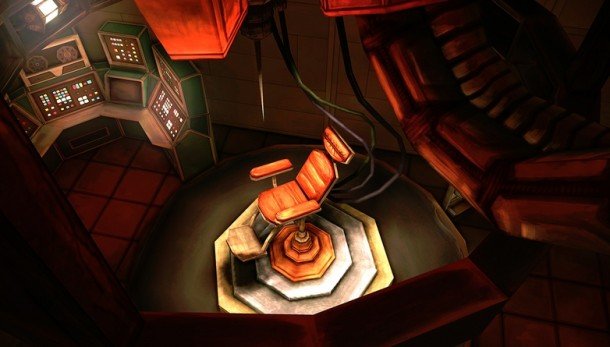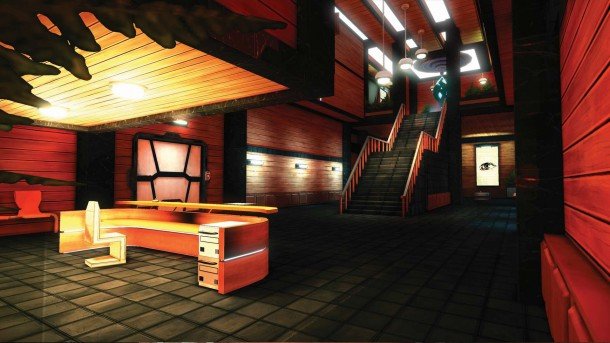Ether One hands-on: explore minds with the Oculus Rift in this sinister psychodrama

I am inside a virtual reality simulation piecing together the broken memories of a drug addict in the 1920s. For some reason, it looks a lot like Cornwall. For added confusion, I'm playing this via an Oculus Rift, meaning I'm inside a virtual reality simulation of a virtual reality simulation. The Rift hasn't even been released yet, and it's already being deconstructed.
This is Ether One, also known as Restorer. It's an adventure game that aims to pinch the first person storytelling of Half Life or Bioshock, but drop the pesky shooting that can get in the way. "We definitely need more games like this," says designer Pete Bottomley of White Paper Games. "I love what the Gone Home guys are doing, we're definitely in the same category." First person pick-stuff-up-and-look-at-it-ers, if you will. Both Gone Home and Ether One are experiments in using environments as characters, very literally in this case, as the game is set inside someone's mind.
"Some people fix cars, I explore hallucinatory memories of Cornwall."
Everything I know I've learned from rifling through desks at HQ before stepping into the memory machine. I'm a "Restorer," a person with the power to enter another's memories. In the setting of Ether One this seems to be a fairly ordinary job. Some people are accountants, some people fix cars, I explore hallucinatory memories of Cornwall. It's a living. Today's assignment is a woman called Jean, who I haven't met or spoken to at all. In fact the only person who's made any contact with me is my boss, a brusque and efficient woman whose voice comes over the radio. She just wants me to get in, repair the memories and get out. Don't stray off the beaten path, don't go looking for other memories, don't ask questions. I instinctively distrust her. I'm not a machine! I take pride in this made up job I only just found out about.
Let's talk about Mental Mindscape Cornwall for a second. In an attempt to save themselves time and money White Paper have gone for a clear, painterly style with their texture work, pulling Ether One away from the ocean of uniform Unreal engine games in both texture and colour palette. Playing it through the Oculus Rift is like I've just stepped into a landscape painting. It's great to see this ridiculous piece of future tech in the hands of a small indie team. Pete credits Epic for that. Unreal Engine 3 has Oculus Rift support built right in, and the result of collaboration between the two companies is that even tiny indie developers like White Paper get to finally fulfil their VR fantasies.

So I begin to explore the world around me, the mines and the buildings that surround them. Every single one is abandoned, as if one day in 1919 the miners collectively decided that digging holes in the ground was for chumps, and decided to enter the burgeoning mental-landscape-wandering industry instead. There's something very eerie about the whole place. I can half make out other explorable areas nearby, but they're all hidden in shadow and just out of reach. Ether One is full of little mysteries, like doors that close just as I approach them, only for my boss to stammer out a quick "Nothing to see here." Despite the ambient weirdness, the experience is all very laid back, no pressure, just exploration and mild puzzles in the haunting Cornish landscape. "I wanted the player to be able to take the game at their own pace." Explains Pete. "I didn't want to have too many timed elements in there, I wanted you to be able to explore and try and figure out and not be rushed through the world."
"Ether One is full of little mysteries, doors that close just as I approach them."
It's at this point that I finally get to find out what 'restoring' is. It's a special kind of interaction that moves a location through time, in this case forcing a damaged elevator to un-collapse and revert to working order. It's very pretty, but ultimately just a flashy way to open up a path to a new area. Pete, however, lets me know there'll be a lot more Restoration points in the full game, many of them optional, offering up new perspectives on the world.
Here I find the central conflict of the game. Jean's memory, here in the shape of a glowing rock that I'm certain I already saw in Restorer HQ at the start of the game. Attempting to deal with the rock/memory means I finally hear Jean's voice, begging me to stop. My boss compels me onwards, but now I'm torn. I'm just getting in to the rhythm of the brain-explorer role, but am I the bad guy here? Jean certainly doesn't seem like she signed up for this impromptu magic mind surgery, and it certainly feels like there's something going on here I'm not being told. On the other hand Jean is, by all accounts, not in her right mind. Is this just her instinct kicking in? Fighting back against the healing process?
The biggest gaming news, reviews and hardware deals
Keep up to date with the most important stories and the best deals, as picked by the PC Gamer team.

As the conflict comes to a head, there's a burst of blue light and Jean's mind begins to unravel. Which is unfortunate, as I'm still standing in it. Things tear apart and are sucked into a black hole, that then forms into the shape of a door. I'm drawn into it, and it opens onto a completely different location, a street that's disintegrating as I run down it, bits of the level careering past my virtual ears. For a second I have to remind myself that only one layer of my dual simulation is going wrong and I'm not about to prove all those 90s filmmakers right about the evils of VR.
"Jean's mind begins to unravel. Which is unfortunate, as I'm still standing in it."
I steer myself from door to door, running through different memories. Jeans mind is tearing itself apart as my boss screams bloody murder in my ear. It's a complete change of tone, as Pete admits. "We wanted that intensity and pacing, we really like that in video games. But we wanted to keep that accessible for the players that aren't necessarily used to PC gaming that want to play puzzle games." That desire to avoid twitch reaction challenges results in another of Ether One's experiments first person storytelling. I'm being forced ever forwards, but I'm still in full control of the camera. I'm even able to veer from side to side, making choices as to which portal door I barge through, although I have no idea what'll be on the other side. It certainly feels free-er than a simple cutscene or forced movement, but I'm never really sure if the choices I'm making matter.
Then, as suddenly as things went crazy, the demo I'm playing ends, and I'm left with more questions than answers. Who should I side with? My boss or the client? What happened to Jean in that mine that tore her brain up so badly? What was lurking behind all those hidden doors? But most importantly, which is the real Ether One? The sedate, atmospheric puzzler that I spent half an hour with, or the sudden breakneck dash through a magical dreamscape that took over at the end? Pete is understandably cagey on the details, though he does confirm that the conflict between Jean and your boss is the one that drives the game. "You're not necessary forced to choose sides" He says. "We want the player to interpret their decisions however they want to and hopefully people will get different perspectives from the story in the end!"
Playing Ether One has left me with more questions than when I started, but they're the good kind of questions. I don't doubt it's possible to make a first person story without violence, I just want to know how it's all going to end.
Find out more on the Ether One site , and take a look at the trailer below for a moving look at that clean art style.

